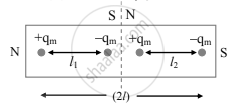Advertisements
Advertisements
प्रश्न
Answer the following question in brief.
What happens if a bar magnet is cut into two pieces transverse to its length/along its length?
उत्तर
- When a magnet is cut into two pieces, then each piece behaves like an independent magnet.
- When a bar magnet is cut transverse to its length, the two pieces generated will behave as independent magnets of reduced magnetic length. However, the pole strength of all the four poles formed will be the same as that of the original bar magnet. Thus, the new dipole moment of the smaller magnets will be,
`therefore m = m xx 2l`
`vec("m"_1)="q"_"m"(vec("l"_1))`, `vec("m"_2)="q"_"m"(vec("l"_2))`
- When the bar magnet is cut along its length, the two pieces generated will behave like an independent magnet with reduced pole strength. However, the magnetic length of both the new magnets will be the same as that of the original bar magnet. Thus, the new dipole moment of the smaller magnets will be
`vec("m"_1)=("q"_"m")_1(2vec("l"))`, `vec("m"_2)=("q"_"m")_2(2vec("l"))`
Pole strength is directly proportional to cross-section area.
APPEARS IN
संबंधित प्रश्न
Magnetic lines of force are closed continuous curves.
An iron needle is attracted to the ends of a bar magnet but not to the middle region of the magnet. Is the material making up the ends of a bare magnet different from that of the middle region?
Two bar magnets are placed close to each other with their opposite poles facing each other. In absence of other forces, the magnets are pulled towards each other and their kinetic energy increases. Does it contradict our earlier knowledge that magnetic forces cannot do any work and hence cannot increase kinetic energy of a system?
A bar magnet of length 1 cm and cross-sectional area 1.0 cm2 produces a magnetic field of 1.5 × 10−4 T at a point in end-on position at a distance 15 cm away from the centre. (a) Find the magnetic moment M of the magnet. (b) Find the magnetisation I of the magnet. (c) Find the magnetic field B at the centre of the magnet.
Choose the correct option.
Inside a bar magnet, the magnetic field lines
Answer the following question in detail.
A circular magnet is made with its north pole at the centre, separated from the surrounding circular south pole by an air gap. Draw the magnetic field lines in the gap.
A short bar magnet placed with its axis at 30° with a uniform external magnetic field of 0.25 T experiences a torque of magnitude equal to 4.5 × 10–2 J. What is the magnitude of magnetic moment of the magnet?
A closely wound solenoid of 800 turns and area of cross-section 2.5 × 10–4 m2 carries a current of 3.0 A. Explain the sense in which the solenoid acts like a bar magnet. What is its associated magnetic moment?
A closely wound solenoid of 2000 turns and area of cross-section 1.6 × 10-4 m2 , carrying a current of 4.0 A, is suspended through its centre allowing it to turn in a horizontal plane.
What is the force and torque on the solenoid if a uniform horizontal magnetic field of 7.5 × 10-2 T is set up at an angle of 30° with the axis of the solenoid?
Which of the following statement about magnetic field lines is true?
The resistance of ideal voltmeter is
The magnetic moment of atomic neon is equal to
At a certain 100 p of reduces 0.0/57 m carrier a current of 2 amp. The magnetic field at the centre of the coop is [`mu_0 = 4pi xx 10^-7` wb/amp – m]
When current is double deflection is also doubled in
A particle having charge 100 times that of an electron is revolving in a circular path by radius 0.8 with one rotation per second. The magnetic field produced at the centre is
Magnetic dipole moment is a ______
A bar magnet of magnetic moment m and moment of inertia I (about centre, perpendicular to length) is cut into two equal pieces, perpendicular to length. Let T be the period of oscillations of the original magnet about an axis through the midpoint, perpendicular to length, in a magnetic field B. What would be the similar period T′ for each piece?
There are two current carrying planar coils made each from identical wires of length L. C1 is circular (radius R) and C2 is square (side a). They are so constructed that they have same frequency of oscillation when they are placed in the same uniform B and carry the same current. Find a in terms of R.
A long straight wire of circular cross section of radius 'a' carries a steady current I. The current is uniformly distributed across its cross section. The ratio of magnitudes of the magnetic field at a point `a/2` above the surface of wire to that of a point `a/2` below its surface is ______.
A bar magnet is demagnetized by inserting it inside a solenoid of length 0.2 m, 100 turns, and carrying a current of 5.2 A. The coercivity of the bar magnet is ______.
